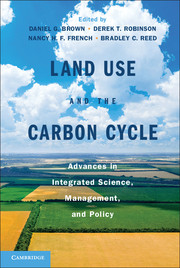Book contents
- Frontmatter
- Contents
- Chapter Authors and Affiliations
- Acknowledgments
- Acronyms
- Part I Introduction
- Part II Measurement and Modeling
- Part III Integrated Science and Research Applications
- Part IV Land Policy, Management, and the Carbon Cycle
- Part V Synthesis and Future Directions
- 20 Forests, Carbon, and the Global Environment: New Directions in Research
- 21 Ecosystem Sustainability through Strategies of Integrated Carbon and Land-Use Management
- 22 Perspectives on Land-Change Science and Carbon Management
- Index
- Plate Section
- References
21 - Ecosystem Sustainability through Strategies of Integrated Carbon and Land-Use Management
Published online by Cambridge University Press: 05 February 2013
- Frontmatter
- Contents
- Chapter Authors and Affiliations
- Acknowledgments
- Acronyms
- Part I Introduction
- Part II Measurement and Modeling
- Part III Integrated Science and Research Applications
- Part IV Land Policy, Management, and the Carbon Cycle
- Part V Synthesis and Future Directions
- 20 Forests, Carbon, and the Global Environment: New Directions in Research
- 21 Ecosystem Sustainability through Strategies of Integrated Carbon and Land-Use Management
- 22 Perspectives on Land-Change Science and Carbon Management
- Index
- Plate Section
- References
Summary
Introduction
Terrestrial ecosystems provide a number of key services to society that are linked to carbon (C) cycle processes, a few of which include controlling food and fiber production, basic building materials, energy sources, and soil water holding capacity. Human societies have developed a number of land-use practices to enhance biological C processes and increase the delivery of many ecosystem services. However, some of the modifications have led to unintended degradation of land systems in ways that have reduced the natural capacity of ecosystems to maintain a range of supporting, provisioning, and regulating services.
As society strives to sustain key ecosystem services while attempting to meet the challenge of a growing human population and manage for climate change, new and sustainable land-use strategies must play a role. Sustainable management practices – those that maintain the provision of ecosystem services at or from a location – should be a main component of any land-use strategy if we are to successfully deal with global environmental challenges. Society is now demanding much more from land-use systems to achieve multiple goals. Multiple ecosystems services are being required from these systems – to provide food, environments for maintaining biodiversity, and production of energy products, and for preventing pollutants from entering the air and waterways. Developing land-system practices and policies that consider the long-term dynamics of C cycling among competing ecosystem services will provide a framework to develop more sustainable land management.
- Type
- Chapter
- Information
- Land Use and the Carbon CycleAdvances in Integrated Science, Management, and Policy, pp. 523 - 538Publisher: Cambridge University PressPrint publication year: 2013
References
- 1
- Cited by

